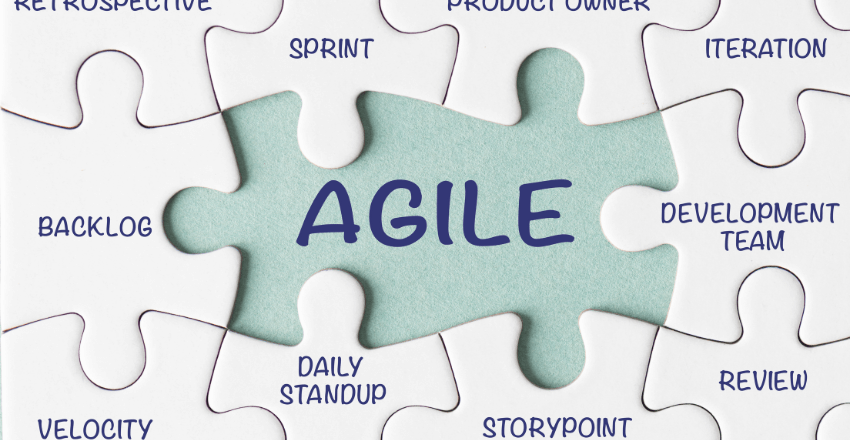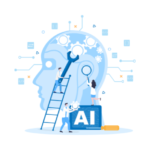
Agile for AI Development teams: The key to harnessing data-driven insights, accelerating delivery timelines, and driving effective, iterative AI innovation.
Agile methodologies have gained significant popularity in software development teams over the years. However, it’s not just limited to software development teams, AI development teams also have a lot to benefit from by adopting Agile methodologies.
By embracing Agile, AI development teams can enhance productivity and collaboration, reduce project timelines, and improve overall quality.
Understanding Agile Methodologies
Agile methodologies are a set of principles and values that guide a team’s approach to software development. Instead of relying on a traditional, linear approach, agile development emphasizes flexibility, collaboration, and iterative development.
One of the key features of agile development is its focus on frequent feedback and short development cycles, known as sprints. This allows teams to adapt their approach and course-correct as needed, instead of waiting until the end of the development process to make changes.
Agile methodologies also prioritize individuals and interactions over processes and tools, and emphasize the importance of communication and collaboration. This means that team members work closely together, share information and ideas, and collaborate to solve problems.
Another important aspect of agile development is its focus on delivering value to the customer. Instead of trying to deliver a fully-featured product all at once, agile development encourages teams to prioritize the most important features and deliver them in small, frequent releases.
This allows teams to get feedback from customers early and often, and make adjustments based on that feedback.
The Need for Agility in AI Projects
AI model development differs from traditional software engineering in several key ways. AI systems are probabilistic, constantly learning from new data. Building, testing, and deploying AI requires rapid iteration and feedback loops.
The needs of the business and the realities of working with data can change frequently.
Waterfall development methods with long release cycles don’t align well with the nature of AI. They increase the risk of misalignment with business needs after months of work. This results in wasted effort and delays in delivering value.
Agile Principles for AI Development Teams
Agile methodologies can help AI development teams work more efficiently and collaboratively towards successful project outcomes.
There are several agile principles that can be applied specifically to AI development teams, including:
| Agile Principle | Description |
|---|---|
| Iterative Development | Breaking down large projects into smaller, more manageable tasks with regular checkpoints and feedback loops. |
| Cross-Functional Teams | Encouraging collaboration between team members with diverse skill sets and backgrounds to tackle complex projects. |
| Regular Communication | Creating an open environment for regular communication and knowledge-sharing between team members. |
| Continuous Improvement | Encouraging ongoing learning and adaptation in response to project challenges and changing requirements. |
By utilizing these agile principles, AI development teams can reduce the risk of project delays, improve accuracy, and enhance the overall quality of their work.
Core Tenets of Agile to Optimize AI Development
Agile frameworks like Scrum and Kanban introduce more nimble, collaborative processes to address these challenges.
Here are some core agile tenets that translate well to AI projects:
- Flexible Adaptation: Adjust and improve processes to better suit changing needs. Review outcomes and incorporate insights from each sprint.
- Early and Continuous Delivery: Release new model versions often to get real-world feedback. This helps validate capabilities and surface areas for improvement.
- Focus on Business Value: Ensure alignment with key business goals and users’ needs to deliver maximum ROI.
Driving Success with Agile AI Principles
Adopting agile practices paves the way for accelerated AI development lifecycles. With an agile mindset focused on iterations, collaboration, and continuous learning, AI teams can build robust models that evolve with business needs.
Key outcomes of agile AI development include:
Faster time-to-value with continuous delivery of working models
Closer alignment between data science and business objectives
Improved model quality through rapid feedback and testing
Higher productivity through flexible, collaborative workflows
Lower risks from changing requirements and data drift
As AI capabilities become increasingly critical, integrating agile principles into development processes can help future-proof initiatives. With agile, AI teams can build trust through transparency, adapt to new learnings, and deliver maximum value.
Scrum: An Agile Framework for AI Development

Scrum is an agile framework that emphasizes teamwork, collaboration, and iterative progress towards a defined goal. While originally designed for software development teams, Scrum can be adapted for AI development teams as well.
What is Scrum?
Scrum is based on the principles of transparency, inspection, and adaptation. It involves breaking down a complex project into smaller, manageable tasks called “sprints.” Each sprint typically lasts two to four weeks and includes planning, executing, and reviewing work.
The team meets daily during a sprint for a short stand-up meeting to discuss progress and identify any obstacles. At the end of each sprint, the team delivers a potentially shippable product increment.
How can Scrum be adapted for AI development?
AI development teams can apply Scrum by breaking down their projects into smaller tasks and prioritizing them based on value and complexity. The team can then work on these tasks during sprints, with the goal of delivering a working AI model at the end of each sprint.
The team can also use various Scrum artifacts, such as a product backlog, sprint backlog, and burn-down chart, to track progress and ensure transparency.
What are the benefits of using Scrum for AI development?
Using Scrum can bring several benefits to AI development teams. It promotes collaboration and communication among team members, which can lead to better results.
It also encourages regular feedback from stakeholders and end-users, allowing the team to adapt and improve their work. Additionally, Scrum can help teams manage their workflow more efficiently and reduce the risk of project failure.
What are the challenges of using Scrum for AI development?
One of the main challenges of using Scrum for AI development is the need for specialized skills and expertise. AI development requires a deep understanding of data science, machine learning, and other related fields.
The team must also be able to work with large datasets, complex algorithms, and sophisticated tools. Another challenge is ensuring that the AI model is accurate and reliable, which can be difficult to achieve given the unpredictable nature of AI.
Section Conclusion:
Scrum is a powerful agile framework that can be adapted for AI development teams.
It provides a structured approach to managing complex projects and encourages collaboration, feedback, and adaptation. However, AI development teams must be prepared to overcome the challenges associated with using Scrum, including the need for specialized skills and expertise.
Kanban: Visualizing AI Development Workflows
Kanban is an agile framework that emphasizes visualizing workflows and limiting work in progress to boost efficiency. This methodology can be particularly useful for AI development teams, where complex tasks and dependencies are common.
The Kanban board is a visual representation of the development process, dividing tasks into columns that reflect their current status – for example, “To Do,” “In Progress,” and “Done.”
This helps team members get a clear understanding of what needs to be done and what has already been accomplished, as well as identify bottlenecks, dependencies, and blockers.
New tasks can be added to the “To Do” column as they arise, and moved across the board as they progress through the development cycle.
Another key aspect of Kanban is the use of work-in-progress (WIP) limits, which help prevent overloading team members and optimize the flow of work. By limiting the number of tasks that can be in progress at any given time, the team can focus on completing each task before moving on to the next one.
This can lead to faster turnaround times, fewer delays, and higher-quality output.
For AI development teams, implementing Kanban can help improve collaboration, reduce lead times, and enhance overall productivity. By visualizing the development process and streamlining workflows, teams can focus on delivering value to stakeholders and iterating on their output in a timely manner.
Applying Kanban to AI Development
Here are some practical steps AI development teams can take when implementing Kanban:
Identify the development stages and divide them into appropriate columns on the Kanban board (e.g. “Research,” “Data Preparation,” “Model Training,” “Testing,” “Deployment”).
Add tasks to the board as they arise, and prioritize them based on urgency and value.
Set WIP limits for each column based on team capacity and velocity, and enforce them to prevent overload.
Use visual cues (such as color coding) to indicate task priority, dependencies, and blockers.
Hold regular stand-up meetings to discuss progress, identify bottlenecks, and adjust the board as needed.
By following these practices, AI development teams can unlock the benefits of Kanban and streamline their workflows for greater impact and success.
Applying Agile Practices to AI Development

Agile methodologies are particularly well-suited to AI development teams due to their iterative and adaptive nature.
Below are some examples of how agile practices can be applied to AI development to enhance efficiency and collaboration.
Iterative Development
Iterative development involves breaking large projects down into smaller, manageable tasks and then working on them incrementally. This allows teams to regularly review progress and make adjustments as needed, reducing the risk of delays or unexpected issues arising.
For AI development teams, this means focusing on smaller features or functionalities in each iteration, ensuring that the team is able to keep pace with the rapidly-evolving field of AI.
Continuous Integration
Continuous Integration involves regularly integrating new code into the existing codebase, with the aim of identifying and resolving conflicts or issues early on in the development process.
For AI development teams, this means incorporating new data or models into the existing system on a regular basis, ensuring that the output remains accurate and up-to-date.
Regular Feedback Loops
Regular feedback loops involve obtaining feedback from stakeholders (such as end-users or product owners) on an ongoing basis throughout the development process. This helps to ensure that the end product meets their needs and expectations.
For AI development teams, this means involving end-users in the development process as much as possible, and regularly testing and validating the output against real-world scenarios.
By applying these agile practices to AI development, teams can benefit from increased efficiency, improved collaboration, and a greater ability to adapt to changing requirements or emerging technologies.
Benefits of Agile for AI Development Teams
Agile methodologies offer numerous benefits for AI development teams. By using agile practices, teams can improve their efficiency, collaboration, and overall performance.
Here are some of the key advantages of using agile methodologies in AI development:
| Benefits | Description |
|---|---|
| Increased adaptability | Agile methodologies allow teams to adapt to changing requirements and respond to feedback more quickly. This is particularly important in AI development, where algorithms and models are constantly evolving. |
| Faster time to market | Agile methodologies emphasize iterative development and frequent releases, which can help AI development teams get products to market faster. |
| Improved collaboration | Agile methodologies encourage cross-functional teams and close collaboration between team members, which can lead to better communication and more effective problem-solving. |
| Better quality | By using agile practices such as continuous integration and regular feedback loops, AI development teams can catch and fix issues earlier in the development process, resulting in better quality products. |
| Reduced risk | Agile methodologies help teams identify and address potential risks and challenges earlier in the development process, reducing the likelihood of costly mistakes or delays. |
Overall, adopting agile methodologies can help AI development teams become more efficient, flexible, and responsive to customer needs. By prioritizing collaboration, continuous improvement, and iterative development, agile teams can achieve better results and deliver higher-quality products.
Challenges and Considerations for Agile AI Development

While implementing agile methodologies in AI development teams can bring numerous benefits, there are also several challenges that teams may face. One of the main challenges is the complexity of AI system development, which can make it difficult to define clear requirements and the scope of work.
Additionally, the application of agile methodologies requires significant cultural and organizational changes. Some team members may be resistant to these changes, and it may take time for everyone to fully adopt the new approach.
Another challenge may be the need for specialized tools and infrastructure to support agile development methods for AI projects. Teams must have access to tools and resources to enable continuous integration and deployment, automate testing, and support iterative development cycles.
Overcoming Challenges
To overcome these challenges, it’s important for AI development teams to take a structured and measured approach to agile adoption. This includes providing clear training and support for team members to understand the new methodologies and tools, and gradually phasing in new processes.
Another approach is to adopt a hybrid methodology, combining some elements of agile methodologies with traditional project management methods. This can help teams to navigate complex projects with uncertain requirements or scope, while still benefiting from some of the advantages of agile methods.
Finally, teams should recognize that agile adoption is an ongoing process that requires continuous improvement. Regular retrospectives and assessments can help teams to identify areas for improvement and fine-tune their approach over time.
Best Practices for Agile AI Development Teams
Agile methodologies can greatly benefit AI development teams in terms of efficiency, collaboration, and adaptability. However, to fully realize these benefits, teams must adopt best practices to ensure the smooth implementation of agile practices.
Here are some best practices for Agile AI development teams:
1. Create Cross-Functional Teams
To maximize the effectiveness of agile methodologies, it’s crucial to ensure that teams are cross-functional. This means that teams should be composed of individuals with a diverse set of skills and expertise to ensure that different aspects of the project are well-represented.
This practice promotes collaboration and can lead to more innovative solutions.
2. Promote Effective Communication
Effective communication is crucial to the successful implementation of agile practices. It’s important to establish clear communication channels and ensure that team members are kept in the loop about project updates, changes in requirements, and feedback.
This communication should be frequent, transparent, and open-ended, allowing team members to express their ideas and discuss potential roadblocks.
3. Use Iterative Development
Iterative development is a key principle of agile methodologies and involves breaking down complex projects into smaller, more manageable tasks. AI development involves a lot of experimentation, testing, and iteration, and this process can become more manageable by breaking it down into smaller tasks.
This approach allows teams to focus on the most important tasks and adjust their approach as needed.
4. Utilize Continuous Integration
Continuous integration involves regularly testing and integrating code changes into the project’s code repository. This practice ensures that changes are integrated quickly and avoids the need for large-scale integration tests.
Continuous integration also allows teams to quickly identify and address potential issues or bugs in their code.
5. Prioritize Regular Feedback
Feedback is an essential component of agile methodologies and helps teams to continuously improve their approach. It’s important to provide regular feedback to team members about their work, as well as to gather feedback from stakeholders and end-users.
This feedback can inform decisions about the project’s direction and help to ensure that the final product meets user needs.
By following these best practices, Agile AI development teams can achieve greater efficiency and collaboration and maximize the benefits of agile methodologies.
However, it’s important to note that the adoption of agile methodologies requires both a cultural shift and a willingness to experiment and adapt. Teams should approach the adoption of agile practices with an open mind and a willingness to continually improve.
Frequently Asked Questions about Agile for AI Development Teams

As agile methodologies become more widespread in AI development teams, there may be questions and concerns raised.
Here are some common FAQs:
What are the key principles of agile methodologies?
The key principles of agile methodologies are flexibility, collaboration, incremental development, and regular feedback loops. These principles are designed to enable teams to respond quickly and adapt to changes in requirements or feedback.
What are the benefits of using agile methodologies in AI development teams?
Adopting agile methodologies can result in increased productivity, better communication and collaboration, faster time to market, and improved adaptability to changes in requirements or feedback. It also promotes a culture of continuous improvement.
What are some common agile frameworks used in AI development?
Two of the most common agile frameworks used in AI development are Scrum and Kanban. Scrum emphasizes team collaboration and uses sprints to deliver incremental releases, while Kanban focuses on visualizing workflows and optimizing the flow of work.
What are some challenges of implementing agile methodologies in AI development?
Some common challenges of implementing agile methodologies include resistance to change, difficulty in adapting to new practices, and lack of alignment or understanding across the team. It is important to address these challenges proactively and to continuously monitor and adjust practices for optimal results.
How can agile methodologies improve communication and collaboration in AI development teams?
Agile methodologies promote frequent communication and collaboration through practices such as daily stand-up meetings, regular feedback loops, and cross-functional teams. These practices create opportunities for team members to share ideas, identify issues, and work together to overcome challenges.
What are some best practices for implementing agile methodologies in AI development teams?
Some best practices for implementing agile methodologies include establishing clear roles and responsibilities, promoting open communication and collaboration, prioritizing work based on business value, and continuously monitoring and adjusting practices based on feedback and results.
What role does continuous improvement play in agile methodologies?
Continuous improvement is a core principle of agile methodologies. It involves regularly reflecting on practices, identifying areas for improvement, and implementing changes to optimize processes and outcomes. This helps teams to continuously learn and adapt to changing requirements and feedback.
How can agile methodologies improve the speed and efficiency of AI development?
Agile methodologies promote continuous delivery, which involves delivering incremental releases frequently and consistently.
This helps to reduce lead time, improve cycle time, and increase throughput. Agile practices such as automated testing, continuous integration, and refactoring can also improve the quality and maintainability of code.
What should AI development teams keep in mind when adopting agile methodologies?
AI development teams should keep in mind that agile methodologies require a cultural shift towards collaboration, flexibility, and continuous improvement. They should also be prepared to adapt practices to suit their specific needs and challenges.
Finally, they should embrace a mindset of experimentation and learning, and be open to feedback and change.
Jane Watson is a seasoned expert in AI development and a prominent author for the “Hire AI Developer” blog. With over a decade of experience in the field, Jane has established herself as a leading authority in AI app and website development, as well as AI backend integrations. Her expertise extends to managing dedicated development teams, including AI developers, Machine Learning (ML) specialists, and other supporting roles such as QA and product managers. Jane’s primary focus is on providing professional and experienced English-speaking AI developers to companies in the USA, Canada, and the UK.
Jane’s journey with AI began during her time at Duke University, where she pursued her studies in computer science. Her passion for AI grew exponentially as she delved into the intricacies of the subject. Over the years, she honed her skills and gained invaluable experience working with renowned companies such as Activision and the NSA. These experiences allowed her to master the art of integrating existing systems with AI APIs, solidifying her reputation as a versatile and resourceful AI professional.
Currently residing in the vibrant city of Los Angeles, Jane finds solace in her role as an author and developer. Outside of her professional pursuits, she cherishes the time spent with her two daughters, exploring the beautiful hills surrounding the city. Jane’s dedication to the advancement of AI technology, combined with her wealth of knowledge and experience, makes her an invaluable asset to the “Hire AI Developer” team and a trusted resource for readers seeking insights into the world of AI.






